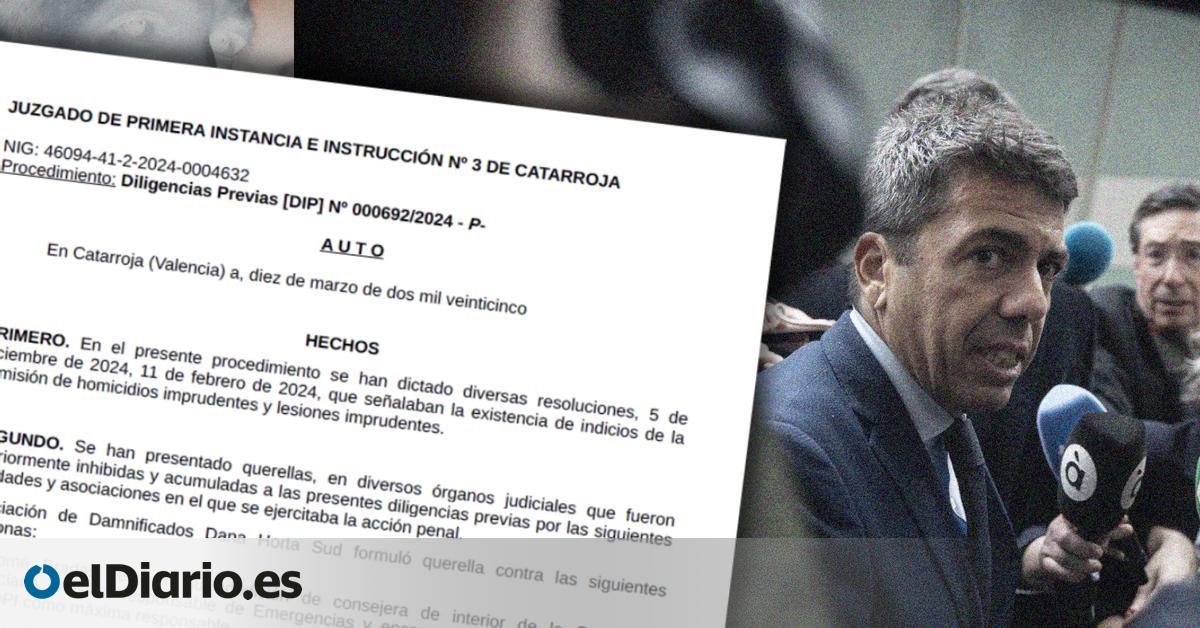
The Judge of the Dana has taken ahead, in a car of just 16 pages, the full version of Carlos Mazón’s regional executive on the disastrous response to the emergency of the ravine on October 29. The resolution does not leave the Generalitat Valenciana or a minimum loom. All the excuses (or co -therades) that Mazón maintains, and therefore the PP of Alberto Núñez Feijóo, have jumped through the air. The “Single Emergency Command” corresponded exclusively to the Consell, the “superior management body and coordination of civil protection.” The Dana was not an “unforeseen weather phenomenon”, since the Aemet warned three days in advance and the University of València agreed to “fortunately” the suspension of the classes the previous day. There was not the many times adduced “informative blackout” by the Júcar Hydrographic Confederation (CHJ). Nor was the “assent or conformity” of the participants in the late meeting of the Integrated Operational Coordination Center (Cecopi) to launch the mass alert to mobile phones. On the contrary, there was a “patent inactivity of the regional administration” that could constitute a “negligence” that led to 228 deaths due to causes that are not “explainable.”
In short, the order of Judge Nuria Ruiz Tobarra, head of the Court of Instruction number 3 of Catarroja, is devastating and pointing out, in a phase still very incipient of the investigation, the negligent action by the Generalitat and the indications of the alleged crimes of reckless homicides.
The young instructor (characterized by her empathy with the victims, her incisive resolutions and her clarity in the research approach) does not go with rodeos. After enumerating the names of the 228 fatal victims and the terrible statements of some of her relatives, the judge dismisses the “ads of the severity of the situation” of the day of the Dana with a “sufficient advance”: the “appropriate notices” of the Aemet; the almost 20,000 calls at 112; The media information that broadcast “clearly” the evolution of floods, and the chj flow measurements.
The magistrate emphasizes that the response to the emergency of the DANA was “exclusive competence” of the Generalitat, according to the Statute of the Autonomy and the current regulations, which awarded the then head of the Ministry of Justice and Interior, Salome Pradas, the exercise of the “Single Command of the Emergency” and the direction of the Civil Protection plans.
The first imputed in the case, due to its “organic” and “decisive” relevance, has been the former prados, followed by its autonomous emergency secretary, Emilio Argüeso. To Mazón, given his condition as Afforado, he cannot quote him to declare as investigated, unless the Chief of the Consell volunteers (a very improbable option). The statements of Pradas and Argües [las de] ES-ALErt system technicians. ”
The alert message: “Late and erroneous”
The car reiterates that the alert message to mobiles – envied at 20.11 – was “late and wrong”, since it did not ask the population to take refuge in height. The first official message in that line was given by the Mazón himself at 21.30, when the deaths had already occurred (the judge called in a previous resolution the transnochado advice of the Chief of the Consell of “completely useless”). “The circumstances of the delay [en el envío de la alerta] They must be found out, ”he says as a warning to navigators.
The instructor believes that emergency managers had “plenty of” information and “by innumerable means, in real time” about the seriousness of the situation. And provides several hypotheses: gravity was ignored; its scope was not understood (“which would be equally serious”); It was not known “where the Poyo ravine” or the situation of the rest of the populations argued, or “the relevant decisions were not made by those who had the power of decision.”
The judge openly questions the recent report of the Director General of Emergencies, Alberto Martín Moratilla, who contributed —pocos-details about the decision to send the ES-ELErt. The instructor is “strange” that “it is intended to download in the technicians the content of the message.” In addition, in the report “it is not said which ones.”
The resolution recalls that the alert was not “the only one” resource to notify the population: official notices through media also “would have been equally useful.”
The magistrate finishes in a forceful paragraph the disastrous emergency management, with meadow at the head of the single command and with an absent mazón until 20.28 in the afternoon, according to its latest version: “The instruction will have to determine the causes, which so far are not explainable, not only for the relatives of the deceased, but for this instructor, of why the population was not indicated to the population that would not be indicated to the population. painful, due to its delay, and incomplete for its content, a message that was scheduled to avoid displacements. ”
It is, the judge concludes, of a “omission in time of the alarms” and of a “erroneous action”, according to the content of the message of the ES-Alert.
The “great delay” of the Cecopi call
The car, in the entrance, remembers the obvious: the Cecopi is a coordination body with other administrations – as “its own name” – in terms of emergencies. “This is completely independent with the decisions that can be made in the field of Civil Protection for whom it holds not only exclusive competence, but the possibility of carrying out communication to the population of protection measures,” says the resolution in reference to Salome Pradas.
On the other hand, the magistrate assures that the Cecopi was convened with a “great delay” and, in addition, the decision -making by the regional administration occurred with an “even greater delay.” And it is that those responsible for the Autonomic Department of Emergencies of the Generalitat were “guarantors” that “the deaths” of a total of 228 people who were in a very high risk situation “were not produced without even knowing it.
“The weather forecasts had to lead to a call in the morning of October 29, 2024 of the Cecopi, to the object, at least, to notify the population,” says the instructor.
In addition, the meeting has already convened, for the pradas for the Minister “it was not necessary” to have “with the assent or conformity” of the participants in the Cecopi to make the decision to send the alert. “Simply [era necesario] Make the decision to notify citizens who could be affected, ”he adds. The car thus demolishes the argumentary of Mazón and its insinuations about the alleged role in sending the alert of the Government delegate, Pilar Bernabé.
The magistrate also does not believe the version version that maintains that Cecopi stopped for more than an hour that afternoon for an “exclusively face -to -face work”, according to the vague expression of Martín Moratilla. It is a mere “euphemism,” clarifies the instructor, who also reproaches the Department of Emergencies and Interior, directed by Juan Carlos Valderrama, that the report sent, just a couple of pages, “it is not an answer to what is requested.”
In addition, Cecopi’s pause shows that the decision “was an autonomous issue,” the car abounds.
The confederation notices and the calls at 112
The PP argument has focused on accusing the CHJ of an alleged “informative blackout” that would have prevented the Generalitat from reacting to the ravine. However, the instructor breaks down the notices of automatic hydrological information systems (SAIH) between 18.00 and 19.20 and two emails (at 16.13 and at 18.43) on the increase in the flow of the Poyo ravine.
The magistrate even slides that those responsible for the emergency department “ignore” the localities located near the Poyo channel, something that “journalists did not know.” “For this, special technical knowledge would not be necessary again,” he rises with a sneer.
In any case, “a ignorance of the emergency people of the Valencian Generalitat of the SAIH or the possibility of access to it, nor in parallel to attribute criminal responsibility to the president of the CHJ [Miguel Polo]nor practically all the managerial positions or not of said body ”. Thus, the judge rules out to mention Polo as investigated, as requested by the Ultra Hazteira entity and the Association of Damnified Dana Horta Sud.
On the other hand, the car also reviews the calls at 112 of the day of the Dana. The Emergency Telephone of the Generalitat began to receive calls related to the flood from the early hours of October 29. In total, 112 received that tragic day almost 20,000 calls. At 16.40, as this newspaper reported, the overflow of the Poyo ravine was already notified. Hours before sending from ES-Alert, 112 received notices about children, pregnant women and babies trapped by the flood.
The role of à punt: “The images are clear”
The judge emphasizes that regional television à Punt was erected in the “preferential channel” to broadcast official information to the population. The auto praisely reviews part of the retransmission of that day in the public chain, with information on the floods in Chiva already in the morning program and even on a rescue by the Firefighters, at 12.02, in Chiva. After the midday informative, in the special program on the Dana, he even alluded to danger in the Poyo ravine, whose overflow hours later downstream caused most of the deaths.
At 18.09, the magistrate stands out, a journalist from à Punt alerted live in the overflow of the Poyo ravine. “The images are clear,” says the instructor judge. The car affects a phrase of the reporter on the ravine: “Fa Fredat” (da terror).
Three minutes later, the judge adds, “the gravity and the flow of the ravine are appreciated with extreme clarity” in à punt. Subsequently, the images of regional television “show that the situation was getting worse.” At 19.14, on the occasion of the fall of the Picanya pedestrian catwalk at the height of the Poyo ravine by the force of water (and almost an hour before sending the ES-Alert), a journalist warns: “A lot of caution if they are next to the Ramblas, of the rivers.”
There was no need to see à punt, the magistrate comes to say: other media also reported that day “profuse” about the evolution of the Dana. The car recalls the “common knowledge” about the “mortal repercussions” that have historically caused floods in the Valencian territory: the “most serious” of the 1957 flood and those of the Tous swampy, in 1982.
“It corresponded to the regional authorities,” Apostille, “alert the population, agree on the relevant measures in the field of civil protection, guarantee and minimize the consequences of the effects of rainfall that overflowed rivers and ravines, put the prey to the limit, and that produced a tragic succession of deaths.” Which, in the instructor’s opinion, is erected in “foundation of negligence with criminal relevance.” That is, of the alleged serious imprudence charged to meadows.
Source: www.eldiario.es

